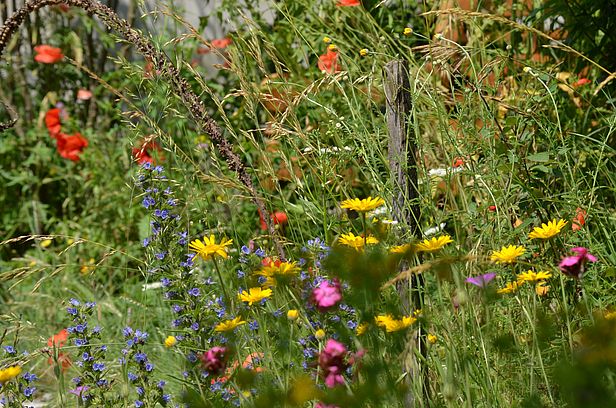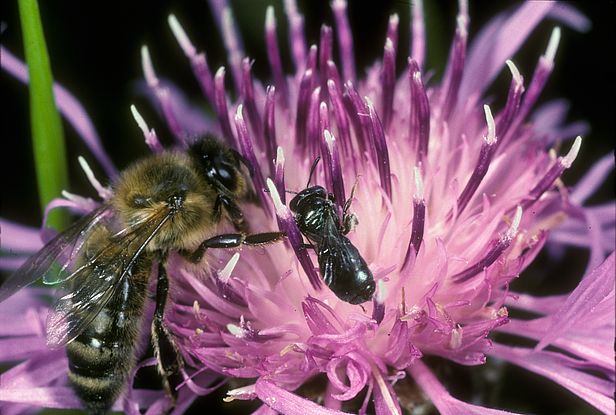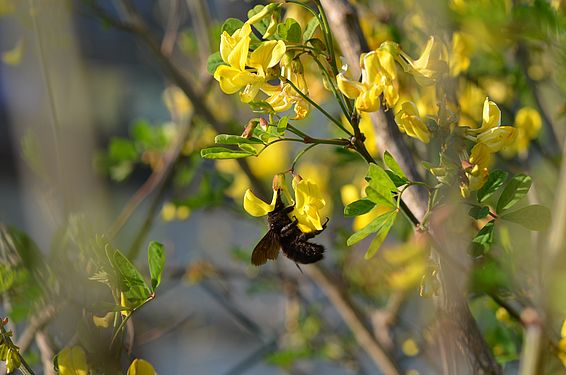14.02.2022 | Fiona Galliker | News WSL
Beekeeping is booming in Swiss cities. But the uncontrolled increase in honeybees is putting increasing pressure on wild pollinators, threatening urban biodiversity, concludes a new study by the Swiss Federal Research Institute for Forest, Snow and Landscape WSL. The results suggest that beekeeping in cities requires better regulation.
The new study aimed to assess the sustainability of urban beekeeping in Switzerland. For this purpose, the two WSL researchers Joan Casanelles Abella and Marco Moretti created a computational model comparing the existing number of hives in fourteen Swiss cities with the available flowering environment between the years 2012-2018. They found that the amount of beehives nearly doubled* in that time, from 3139 to 6370*. The model weighs the honeybees’ demand for green space against their actual availability. For the majority of the cities the model indicated a negative balance, suggesting that there is an insufficient supply of floral resources to satisfy the demands of the honeybees. «The key message from our results is that urban green spaces can't keep up with the existing density of hives», Casanelles Abella says. The researchers’ findings confirm a similar trend observed in other European cities such as Paris, Berlin or London.
According to a scientific study from Great Britain, 7.5 beehives per km2 of green space is a suitable limit for a sustainable beehive density. In Switzerland, however, only rural areas comply with this value, whereas in cities the hive distribution is much more dense and frequently exceeds the limit. Even when the researchers simulated an increase in urban green space with a model calculation, there was no significant improvement. «Increasing green spaces by 75 percent is very unrealistic anyway, but it shows that in truth there are simply not enough resources», Casanelles Abella says.
Competition with wild pollinators ¶
In addition, honeybees are not the only pollinating insects in cities. «When you overcharge a system beyond its carrying capacity, you automatically exhaust all its resources. In turn, this causes the other organisms that depend on the same resources to suffer», Casanelles Abella says. Thus, the food shortage affects all insects that feed on the same flowering plants as the managed honeybees, including wild bees. Of the approximately 600 wild bee species in Switzerland, roughly 45 percent are considered endangered. Cities can harbor a surprisingly large diversity of wild bees species, 164 in the case of Zurich, a recent WSL study showed.
At this point, the exact extent of the negative effects of beekeeping on biodiversity is difficult to assess. Urban beekeeping adds to the already decreasing wild bee diversity, with bees suffering from the combined actions of all ongoing global stressors. These include climate change as well as the lack of flower resources and pests. «We're in a phase where biodiversity is steadily declining and nature is already facing major challenges.»
Honeybees are livestock, too ¶
According to Casanelles Abella, there is primarily a lack of information and control. «People often perceive honeybees as wild animals because they live and move freely. In reality, however, they are kept and bred just like other livestock. And as for these, humans must provide an adequate food supply for honeybees.»
Traditionally, beekeeping is a form of agriculture, but in cities, the breeding of honeybees has increasingly become a recreational activity. The vast majority of people who are keeping honeybees are individuals who want to contribute to a natural environment. It is relatively easy to get started with recreational beekeeping; the only legal requirement is the registration of the new bee colony. A training is merely a recommendation.
There are no regulations regarding where and how far apart the hives should be placed. «We need to come up with a clever strategy to control the density of beehives, just like you do with other livestock, without negatively affecting people's good will», Casanelles Abella says. Possible approaches, according to him, would be to introduce legally required minimum distances between bee colonies, define areas in the city of high value for wild bees, as well as better monitoring of the available floral resources. This could for example be accomplished by using biodiversity maps.
Additionally, the public needs to be better educated about the adverse effects of beekeeping, so that urban biodiversity is not thrown out of balance. Cities contain important habitats and, if managed sustainably, can contribute significantly to biodiversity conservation.
* corrected on 04/28/2022

Contact ¶
Copyright ¶
WSL and SLF provide the artwork for imaging of press articles relating to this media release for free. Transferring and saving the images in image databases and saving of images by third parties is not allowed.




